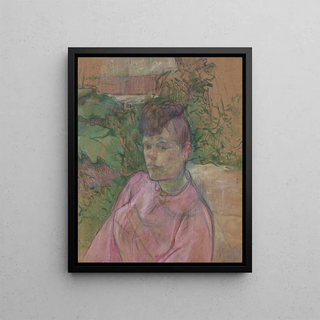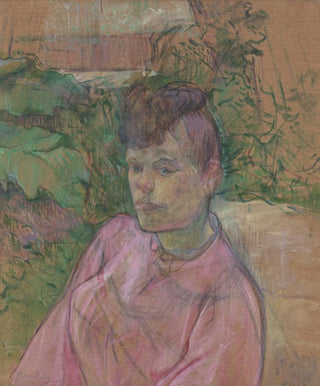Art print | Woman in Monsieur Forest's Garden - Henri de Toulouse-Lautrec


View from behind

Frame (optional)
Captivating Introduction
In the vibrant universe of art, some works manage to capture the essence of an era while revealing the unique sensitivity of their creator. "Femme dans le jardin de Monsieur Forest" by Henri de Toulouse-Lautrec is a perfect example. This canvas, which evokes a scene of everyday life, immerses us in the atmosphere of Parisian gardens at the end of the 19th century. Through his bold use of colors and shapes, Lautrec succeeds in immortalizing a fleeting moment of beauty and tranquility, while offering a reflection on the female condition of his time. The art print of this work allows us to rediscover the delicacy and depth of Lautrec's art, while paying tribute to his sharp eye on society.
Style and uniqueness of the work
Toulouse-Lautrec's style is characterized by a modern and daring approach that challenges the artistic conventions of his time. In "Femme dans le jardin de Monsieur Forest," he deploys a palette of vibrant colors, where greens and yellows blend to evoke the sunlight filtering through the foliage. The composition is both simple and complex, capturing the movement and grace of the depicted woman while integrating the natural elements of the garden. The brushstrokes, both swift and precise, inject a dynamic energy into the scene, creating a lively atmosphere. This work stands out for its ability to transcend a simple portrait, inviting the viewer to feel the emotion of a shared moment in nature, far from urban tumult.
The artist and his influence
Henri de Toulouse-Lautrec, an emblematic figure of post-impressionism, established himself as one of the great masters of his time. His life, marked by personal challenges, infused his art with emotional depth and a unique sensitivity. Lautrec was influenced by the artistic and bohemian circles of Montmartre, where he mingled with artists and models who fueled his inspiration. His sharp eye on society, particularly on the world of women and artists, allowed him to create works that still resonate today.

Matte finish

View from behind

Frame (optional)
Captivating Introduction
In the vibrant universe of art, some works manage to capture the essence of an era while revealing the unique sensitivity of their creator. "Femme dans le jardin de Monsieur Forest" by Henri de Toulouse-Lautrec is a perfect example. This canvas, which evokes a scene of everyday life, immerses us in the atmosphere of Parisian gardens at the end of the 19th century. Through his bold use of colors and shapes, Lautrec succeeds in immortalizing a fleeting moment of beauty and tranquility, while offering a reflection on the female condition of his time. The art print of this work allows us to rediscover the delicacy and depth of Lautrec's art, while paying tribute to his sharp eye on society.
Style and uniqueness of the work
Toulouse-Lautrec's style is characterized by a modern and daring approach that challenges the artistic conventions of his time. In "Femme dans le jardin de Monsieur Forest," he deploys a palette of vibrant colors, where greens and yellows blend to evoke the sunlight filtering through the foliage. The composition is both simple and complex, capturing the movement and grace of the depicted woman while integrating the natural elements of the garden. The brushstrokes, both swift and precise, inject a dynamic energy into the scene, creating a lively atmosphere. This work stands out for its ability to transcend a simple portrait, inviting the viewer to feel the emotion of a shared moment in nature, far from urban tumult.
The artist and his influence
Henri de Toulouse-Lautrec, an emblematic figure of post-impressionism, established himself as one of the great masters of his time. His life, marked by personal challenges, infused his art with emotional depth and a unique sensitivity. Lautrec was influenced by the artistic and bohemian circles of Montmartre, where he mingled with artists and models who fueled his inspiration. His sharp eye on society, particularly on the world of women and artists, allowed him to create works that still resonate today.






